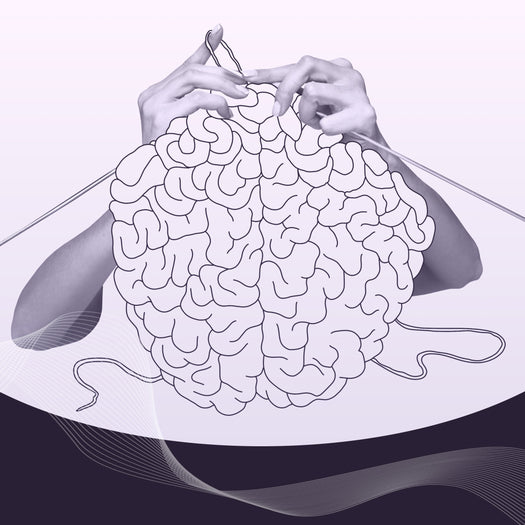Neuroplasticity 101: How To Make Brain Changes That Stick

You don’t need another app or productivity hack. You already have the most powerful upgrade inside you—your brain. (The second best is the new Muse upgrade).
Your brain is always changing. Every habit, every reaction, every new skill triggers small but meaningful shifts in how your brain is wired. That’s neuroplasticity [1]. It’s your brain’s ability to adapt, rewire, and build new patterns based on experience [2].
And with the right approach, you can train it.
Let’s break down how neuroplasticity works—and how to make changes that stick.
Here's some quick insights: Muse Meditation Teacher and Neurosculpting®, founder Lisa Wimberger shares how to hack your brain to make positive change that sticks. Her work brings practical tools to support focus, clarity, and nervous system regulation.
Learn more about the Neurosculpting Institute by watching below.
Learn more about Neuroscultping®>
Neuroplasticity: your Inner OS update
Tech is moving fast—and so is the demand on your brain.
AI tools, immersive workspaces, and always-on communication are reshaping how we think, work, and recover. In 2023, global digital content consumption grew by over 30%, while average attention spans dropped to just 47 seconds per task [3].
You feel that kind of strain by 2pm. Scattered, tired, off your game.
Lasting change doesn’t come from tech alone—it comes from training your brain via mental fitness.
That’s your real operating system. And it updates every time you practice focus, recovery, and emotional control.
Your brain and spinal cord form the core of your central nervous system. And they’re built to adapt. Neuroplasticity is how your brain rewires in response to everything you do—from your habits and thoughts to your sleep and breathwork [4].
It’s not just about healing or recovery. Neuroplasticity is the foundation of high performance. It powers sharper focus, faster learning, and better regulation under pressure.
While the world races ahead with external innovations, the most powerful tool you have is internal.
So, what does training it actually look like?
The Adaptable Brain
Your brain is built for efficiency. It relies on past patterns to predict what’s next. That’s why you might repeat old habits—even when you know they’re not helpful.
Change takes support. For your brain to rewire, it needs energy and resources: quality sleep, consistent nutrition, emotional regulation, movement, and strong social connection [5][6].
When those systems are in place, your brain becomes more flexible. You can shift your perception, update old patterns, and reshape how you relate to stress, memory, and even trauma [9].
That’s neuroplasticity—the brain’s ability to rewire. And the best part is that it can be improved with practise.

The Basics of Neuroplasticity
At a basic level, neuroplasticity refers to our brain’s ability to learn and work more efficiently. In practice, neuroplasticity involves an intricate interplay between neurons, synapses, and neurotransmitters in the brain.
Neurons are the cells responsible for initializing action (called action potentials) in the brain. Synapses and neurotransmitters act as the messaging system and messengers for action potentials between neurons.
Plasticity refers to the ability for something to be reshaped or molded. In this case, it refers to the molding of neural pathways (the messaging highways for action potentials) in the brain [5, 6].
How are these pathways molded?
Essentially, the more we repeat a certain action, the stronger that neural pathway becomes. Think of it like skiing down a mountain. In the morning, you have a fresh slope, with no previous ski tracks for you to follow. You go down the mountain once, and you create a pair of tracks to follow. You go down again, and you deepen the grooves of the tracks. You go down a third time, and the path becomes much easier to follow because you’ve already carved the path twice before. You’re able to use less energy and effort the more you repeat yourself.
If you want to look at it from a biological perspective, each time you perform an action, a complicated orchestra of neurons is firing at specific moments to facilitate said action. The more you repeat the action and use those synaptic pathways, the stronger the connections become, making it easier to repeat the action in the future. In essence, “neurons that fire together, wire together.”
Ultimately, neuroplasticity keenly shows how the structure and function of our brains are shaped by the stimulation of the environment. (Hubel & Wiesel)
Types of Neuroplasticity
There are two main types of neuroplasticity: functional and structural.
Structural plasticity refers to the brain’s ability to change its structure as a result of learning. Essentially, as you learn a new skill, your brain quickly categorizes all the circumstances that prompted you to take action and the action you took, so you can repeat it more easily in the future. In other words, you strengthen neural connections associated with specific skills, so you can repeat it faster and more effectively next time.
Functional plasticity refers to how if a brain area associated with a certain type of function is damaged, other areas of the brain can learn to function in its place.
For example, studies have shown that stroke patients recovering from brain injuries to areas of the brain thought responsible for motor control (ie walking or talking) are able to regain certain skills that were once lost via functional neuroplasticity. [5]
Factors that can impact neuroplasticity
Although each of us is born with the innate gift of neuroplasticity, there are many factors that can influence our brain’s capacity for plasticity.
Research has found several factors can positively affect neuroplasticity, including [6, 7]:
- Regular physical activity
- Getting quality sleep
- Balanced nutrition
- Mindfulness practices
Factors that may adversely contribute to neuroplasticity include [11, 12, 13]:
- Age
- Trauma (specifically childhood trauma and Adverse Childhood Events)
- Stress
-
Mood disorders
Additionally, research has also found that neurodegenerative disorders like Alzheimer’s and reduced cognitive function are often accompanied by poor neuroplasticity. [8]
Neuroplasticity & Creating New Connections
Neuroplasticity works like this. Your brain experiences something. You remember that thing and store it as a template. The next time you experience something similar to the original event your brain says, “yes, I remember how to navigate things like this.” It reaches for that template to efficiently guide your behavior. And then it adds the current iteration to the template, the way an author adds a page to a story making it richer and more integrated. The more we do things, the easier it is to do them. This goes for thinking certain thoughts as well.
The amazing thing is we can intentionally change these templates with directed awareness. We can choose, through mental and physical exercises, to override old templates and create new ones to guide our behaviors. So the fascinating thing about neuroplasticity is that we create the world from the inside out, programming it through our actions, thoughts, experiences, and sensations.
Shaping Your Brain
You are the programmer of your own operating system, which responds to many languages. Some of the languages that speak directly to the nervous system and leverage intentional adaptability are things like Neurosculpting® meditations and wearable tech like the Muse® headband.
A recent study published in the Journal of Yoga, Physical Therapy and Rehabilitation investigated the effects of 11 weeks of Neurosculpting® on sleep, stress, and heart rate. The 5-step meditation program was designed to encourage an individual to make new and more supportive patterns, habits, and behaviors by intentionally engaging the whole brain through specific language and focused imagery. Participants who completed the program showed improvements in sleep and a positive temporary effect on resting heart rate and heart rate variability. [7]
So really, your brain learns from any experience that combines learning and applying new skills. After all, neuroplasticity is the process of rewiring the brain based on our experiences and conscious choices. So you can spur on and support your brain’s neuroplasticity through many different activities, that require your brain to learn and adapt, such as:
- Learning a new skill
- Music therapy
- Using language (writing, speaking, learning)
- Physical activity and exercise
- Meditation and mindfulness practices
Additionally, developing a healthy lifestyle that prioritizes quality sleep, nutrition, stress management, and physical activity can be beneficial in supporting your neuroplasticity.
The amazing thing is that while the outside world is trying to catch up to the speed with which the internet evolves, your nervous system is so far beyond Web 3 in its capacity that it just might be the most potent frontier of our evolution.

Meditation and Your Brain
You may be wondering, why meditation? How is meditation or mindfulness any more beneficial than other neuroplasticity-supporting activities like skill acquisition?
Meditation and mindfulness support neuroplasticity in several fashions.
First, mindfulness and meditation involve the practice of becoming aware of our thoughts, feelings, and experiences. This practice empowers us with the opportunity to choose our emotional landscape with greater intentionality. In this way, mindfulness practices can give us the essential skill of being able to see our habits of thoughts, feelings, and actions, and rewire our habits toward our desired outcomes. This rewiring engages and supports neuroplasticity.
Secondly, meditation and mindfulness have a direct impact on several aspects of our brains, including function and volume.
For instance, meditation has been found to improve stability in the ventral posteromedial cortex (vPMC), which is related to mind-wandering and impulsive thoughts. [11]
Another study by Harvard Neuroscientist Sara Lazar found that meditation increased the size of several brain regions, including the left hippocampus (associated with learning, memory, self-awareness, and empathy). [12]
Final thoughts
So here we sit… At the precipice of so many new and exciting advancements in the world of virtual reality, augmented reality, and neurofeedback. And yet, the greatest area for potential, remains within you. There are so many ways to leverage these evolving technologies to better ourselves, and by doing so, unleash our potential and benefit the rest of the world at large.
Sources:
[1] Pascual-Leone, A., Amedi, A., Fregni, F., & Merabet, L. B. (2005). The plastic human brain cortex. Annual Review of Neuroscience, 28, 377–401.
[2] Draganski, B., Gaser, C., Busch, V., Schuierer, G., Bogdahn, U., & May, A. (2004). Changes in grey matter induced by training. Nature, 427(6972), 311–312.
[3] Microsoft. (2023). Attention spans research report. Retrieved from https://www.microsoft.com/en-us/research/publication/attention-spans/
[4] Draganski, B., Gaser, C., Busch, V., Schuierer, G., Bogdahn, U., & May, A. (2004). Changes in grey matter induced by training. Nature, 427(6972), 311–312. https://doi.org/10.1038/nature02135
[5] Neuroplasticity. (n.d.). Encyclopædia Britannica. Retrieved April 16, 2025, from https://www.britannica.com/science/neuroplasticity
[6] Buonomano, D. V., & Merzenich, M. M. (1998). Cortical plasticity: From synapses to maps. Neuron, 20(3), 421–435. https://www.cell.com/fulltext/S0896-6273(00)81109-5
[7] Hölzel, B. K., Lazar, S. W., Gard, T., Schuman-Olivier, Z., Vago, D. R., & Ott, U. (2011). How does mindfulness meditation work? Proposing mechanisms of action from a conceptual and neural perspective. Perspectives on Psychological Science, 6(6), 537–559. https://www.ncbi.nlm.nih.gov/pmc/articles/PMC5504954/
[8] Reuter-Lorenz, P. A., & Park, D. C. (2014). How does it STAC up? Revisiting the scaffolding theory of aging and cognition. Neuropsychology Review, 24(3), 355–370. https://www.ncbi.nlm.nih.gov/pmc/articles/PMC3622463/
[9] Nelson, S. (2019, January 27). Trauma-informed care, neuroplasticity, and mindfulness. CPTSD Foundation. https://cptsdfoundation.org/2019/01/27/trauma-informed-care-neuroplasticity-and-mindfulness/
[10] Davidson, R. J., & McEwen, B. S. (2012). Social influences on neuroplasticity: Stress and interventions to promote well-being. Nature Neuroscience, 15(5), 689–695. https://www.nature.com/articles/1301574
[11] Takeuchi, H., Sekiguchi, A., Taki, Y., Yokoyama, S., Yomogida, Y., Komuro, N., ... & Kawashima, R. (2012). Training of working memory impacts structural connectivity. The Journal of Neuroscience, 32(15), 5242–5250. https://www.jneurosci.org/content/32/15/5242
[12] Bavelier, D., Green, C. S., Pouget, A., & Schrater, P. (2010). Brain plasticity through the life span: Learning to learn and action video games. Annual Review of Neuroscience, 33, 391–416. https://www.ncbi.nlm.nih.gov/pmc/articles/PMC3004979/
